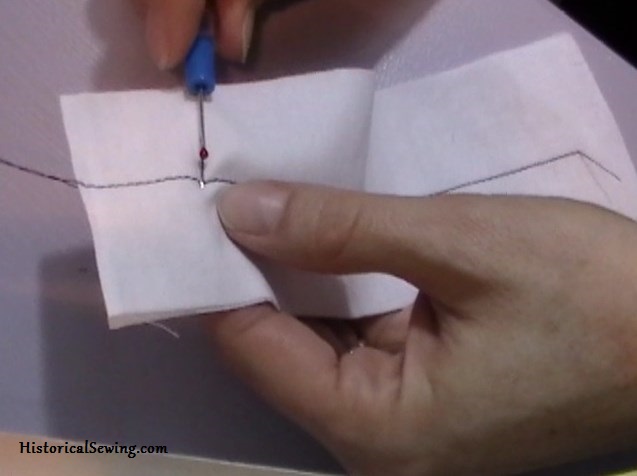
If you sew you rip. Period. No “Oh, I won’t make any mistakes” or “If I sew a seam wrong I simply cut out a new piece.” Yeah… that’s a bit ridiculous.
Everyone knows you use a handy-dandy seam ripper (or tiny scissors) to pull out each little stitch. But do you know the easier way to pull out that seam than simply cutting each stitch?
In this video tutorial you’ll find the easiest way to rip a seam as well as a nifty trick once you’ve pulled that sucker apart.
Do you have a favorite way to rip seams? Does it involve chocolate or adult beverages sometimes? (of course!) 🙂

Thank you for the duck tape idea. Here’s an idea I also used, I used an electric seam ripper. I ripped open the sides of 110″ drapes in about ten minutes.
I pin the dickens out of some projects. A friend of mine said she hates pinning and does as little as possible. I asked whether she’d rather deal with pins or rip a seam, and she said she hadn’t thought about that before and will probably pin more!
I’ve been using the techniques in your video and have little trouble with ripping seams. When I do have trouble, it’s because of short stitches, fine fabric, and/or exact-match thread; I’ve learned to avoid such situations whenever possible!
I do have a question: when opening a narrow buttonhole, how can one avoid cutting the threads at either side? Cutting through the end hasn’t been a problem since I started putting a pin across to stop the ripper, or just cutting from each end toward the middle. But my new machine puts the stitches of one side so close to the stitches of the other that I can’t manage to open the buttonhole without catching a few of the stitches too! Any tips?
I generally open my buttonholes with a seam ripper: poke down at one end and rip halfway, then repeat with the other side. Most times I’ll keep my machine’s buttonhole setting on until after I open the holes in case some threads DO get cut and I have to zigzag over that area again. Pins at the ends are great!
Maybe a buttonhole cutter?? It’s a metal chisel you pound into the slit to open. But the threads are still at risk of being cut if your machine makes stitches too close. I’ve also tried cutting the slit first then doing a machine zigzag at the sides with bar tacks at the ends, which will prevent any accidents with cutting but may be a bit more challenging to sew and complete the full stitches. But it works.
A lint roller is one of my must have sewing tools. It’s great for running over a freshly ripped seam and picking up most of those small threads (and keeps my thumb and index finger from cramping up if I have to pick out all those threads from a long seam!)
Duct tape works even better, faster, cheaper.
I try it my way first, but if that doesn’t work I do it your way.
Free one of the threads up with a thread puller until you can grasp it with your fingers then yank on the freed thread. If the thread tension/stitch length was good the thread can easily be pulled through the fabric. Every so often you might have to cut the stitching further along though, or deal with the fabric bunching up.
Thank you so much for your demo on making a bustle skirt….. I bought a pattern for a beautiful bustle dress and skirt, approximately 4 months ago. After cutting out all the paper pattern pieces I was then left in a quandary as to what to do next, as there were far too many pieces for me to attempt making my very first dress.
I decided to use a rather appropriate skirt that I had already bought already made up, and attempt to make an added bustle to go on the back. I was still hesitant as wasnt sure what my first step should be. I found the inspiration from watching your video, and am now eager to ‘get sewing’… thank you again, a truly wonderful video.
Regards, Shirlie 🙂
I’ve always used the method in your video, but the method shown in Alica Kester’s video looks genius. I suspect it will only work for more robust fabrics – organzas have a tendency to catch on everything and sadly they seem to be the ones I most find myself needing to unpick…
What I like to do most of the time, is to only cut the thread once and then instead of cutting I just pull the thread through. Eventually the threadbwill get long enough to become cumbersome and then I cut the thread and start over. The only thing I hate more than seam ripping is trying to make sure I’ve gotten all the tiny pieces of thread out of the fabric.
This is not my video, but I use this method whenever possible (it doesn’t work on all fabrics.) I can literally rip an entire seam in seconds.
I have yet to make it through a project without having to rip a seam (curse you perfectionism!). I do it much like the video. Sometimes I will cut every 5 – 6 stitches on the top first. My suggestion for new sewers is to make your stitches longer so they are easier to rip later. I have a terrible habit of doing the shortest stitches possible and those are impossible to rip out!
Yes, (Re: R. R. Starr’s comment) I find the default length on my machine much too short. Seems like it could easily rip the fabric with any stress on it.